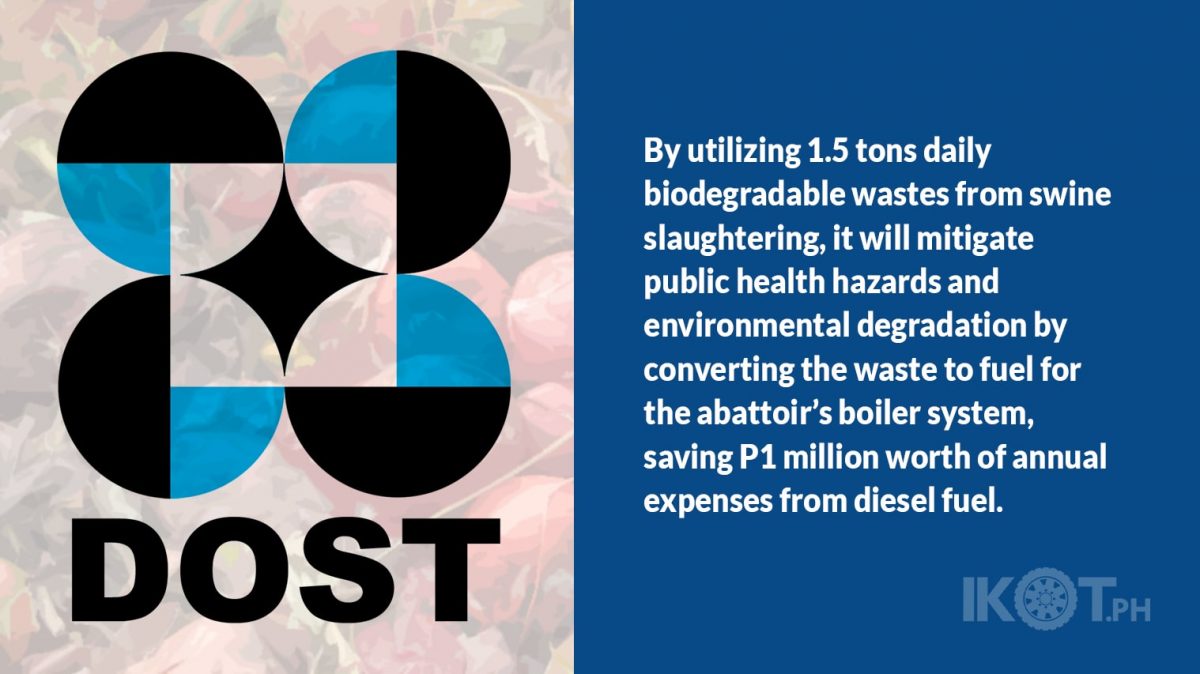The biggest and most modern abattoir in the Bicol Region located at San Roque, Legazpi City is now rising to become the region’s first abattoir to embrace biogas technology, thanks to the collaborative project “Piloting of Biogas Technology for Thermo-Electro-Mechanical Applications for the Legazpi City Abattoir of DOST-V” of the Provincial S&T Center – Albay and the Legazpi City government.
By utilizing 1.5 tons daily biodegradable wastes from swine slaughtering, it will mitigate public health hazards and environmental degradation by converting the waste to fuel for the abattoir’s boiler system, saving P1 million worth of annual expenses from diesel fuel.
According to Dr. Estipona, Legazpi City Abattoir presently pioneers the use of biogas technology in the Philippines as a solid waste management program and solid waste diversion program.
Through the P500,000 worth of project funding provided by DOST-V, the abattoir now contains a floating gasholder-type biogas digester, designed by DOST-V’s very own Albay Provincial S&T Director Engr. Jacinto Alexis B. Elegado.
As a counterpart, LGU-Legazpi has allocated P450,000 for the biogas generator, biogas scrubber and the biogas refining setup.
In a radio-TV interview with DZGB-AM on 29 May 2021, Engr. Elegado and LGU-Legazpi City Veterinarian Dr. Manny Estipona announced that testing of the biogas digester using a heavy-duty gas burner already yielded blue flame.
In addition to ensuring contamination from chemicals that may kill the methanogenic bacteria responsible for methane gas production, the biogas digester’s usage was designed and incorporated with safety auxiliaries such as pressure gauges and automatic shut-off valves.
The second phase of the project will focus on converting the biogas to mechanical energy to drive the motor and convert it to electrical energy through a generator attachment.
A study on purifying the biogas from 50% to 100% methane, so it can be compressed in LPG tanks to be used by LPG taxis, is also underway.
The biogas digester can generate 3kg/day LPG or equivalent to 113 LPG tanks annually, and 104 tons of high-grade fertilizer plus liquid effluents as no-odor-fertilizer.
The biogas technology is also applicable to poultry, since the best biogas producer are those from chicken manure, then from cow and carabao manure.
With effluent pollutants reduced to 35%, water from the digester can be released with no harmful effects on the environment.
The biogas digester will also generate organic fertilizer from sludges which can be added with swine hair to produce a slow-release, high-grade organic fertilizer.
With the current reliance on inorganic fertilizer, this production will greatly assist in the Department of Agriculture’s goal of increasing organic matter in all farming systems.
According to Dr. Estipona, Legazpi City Abattoir presently pioneers the use of biogas technology in the Philippines as a solid waste management program and solid waste diversion program.
Other LGUs are looking forward to the success of the project to replicate the technology in their respective areas.
On whether the sludges in the rivers in Legazpi City can also be fed to the biogas digester, Engr. Elegado explained that it is possible; however, it will entail costs on assimilation tanks for segregation.
The biogas technology is also applicable to poultry, since the best biogas producer are those from chicken manure, then from cow and carabao manure.
The interview with Engr. Elegado and Dr. Estipona during the 29 May 2021 episode of DZGB-AM’s program “Boses kan Kapalibutan” can be viewed below.


